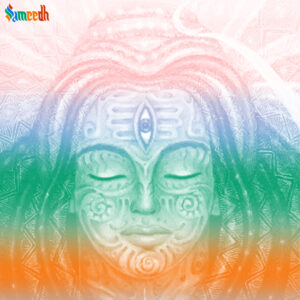Lord Shiv is often referred to as the “Three-Eyed God” because he is depicted with a third eye, known as the “Ajna Chakra” or the “Gyana Netra” (eye of wisdom). This third eye is symbolic and holds deep spiritual significance in Hindu mythology and philosophy. The third eye represents insight, knowledge, and the destruction of ignorance.

There are several myths and stories associated with Shiv’s third eye:
- Incident with Kamadev: One of the most well-known stories about Shiv’s third eye is related to the god of love, Kamadev. According to the myth, Kamadev tried to arouse passion in Shiv by shooting an arrow of love at him. However, Shiv, in deep meditation, was disturbed by this act. In response, he opened his third eye, and the fire of his gaze burnt Kamadev to ashes. This incident signifies the control over desires and the destructive aspect of Shiv’s third eye.
- Destruction of Daksh’s Yajna: In another myth, Shiv’s third eye played a crucial role in the destruction of Daksha’s Yajna (sacrificial ritual). Daksha, the father of Shiv’s wife Sati, insulted Shiv by not inviting him to a grand Yajna. Sati, feeling hurt, immolated herself in the fire of the Yajna. Enraged by this, Shiva opened his third eye, and the intense heat emanating from it destroyed the Yajna and punished Daksh.
- Symbol of Wisdom and Perception: The third eye is also symbolic of higher perception and wisdom. It represents the ability to see beyond the physical world, gaining insight into the true nature of reality. Shiv’s third eye is often associated with inner vision and the awakening of spiritual knowledge.
- Trilokpati – Lord of the Three Realms: The three eyes of Shiv also represent his lordship over the three realms: the physical world (Bhuloka), the mental or psychic world (Antariksha-loka), and the world of the spirit or the celestial world (Swargaloka). As Trilokpati, Shiv oversees and governs all aspects of existence.
In summary, the designation of Shiv as the “Three-Eyed God” is a symbolic representation of his multifaceted nature, incorporating the aspects of destruction, wisdom, and omniscience. It signifies his role as a cosmic deity overseeing the cycle of creation, preservation, and dissolution in the universe.
